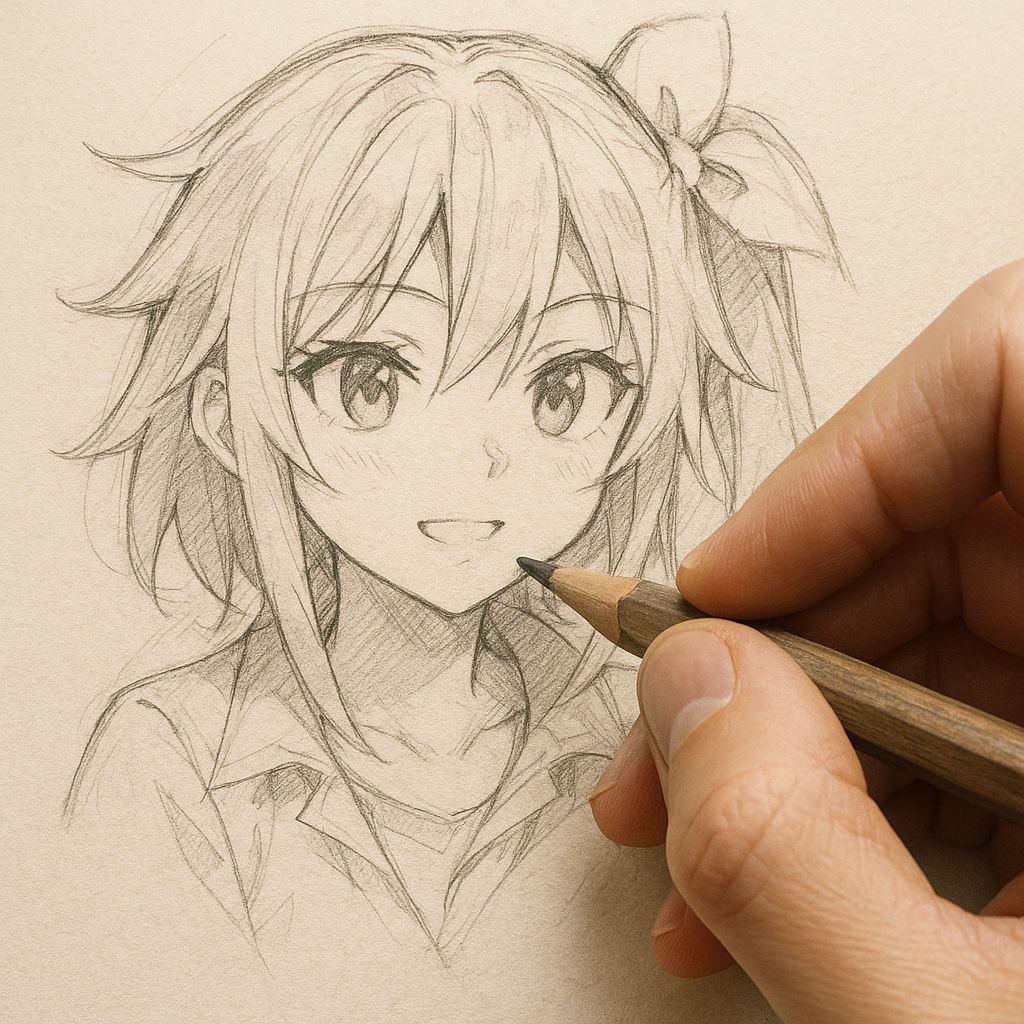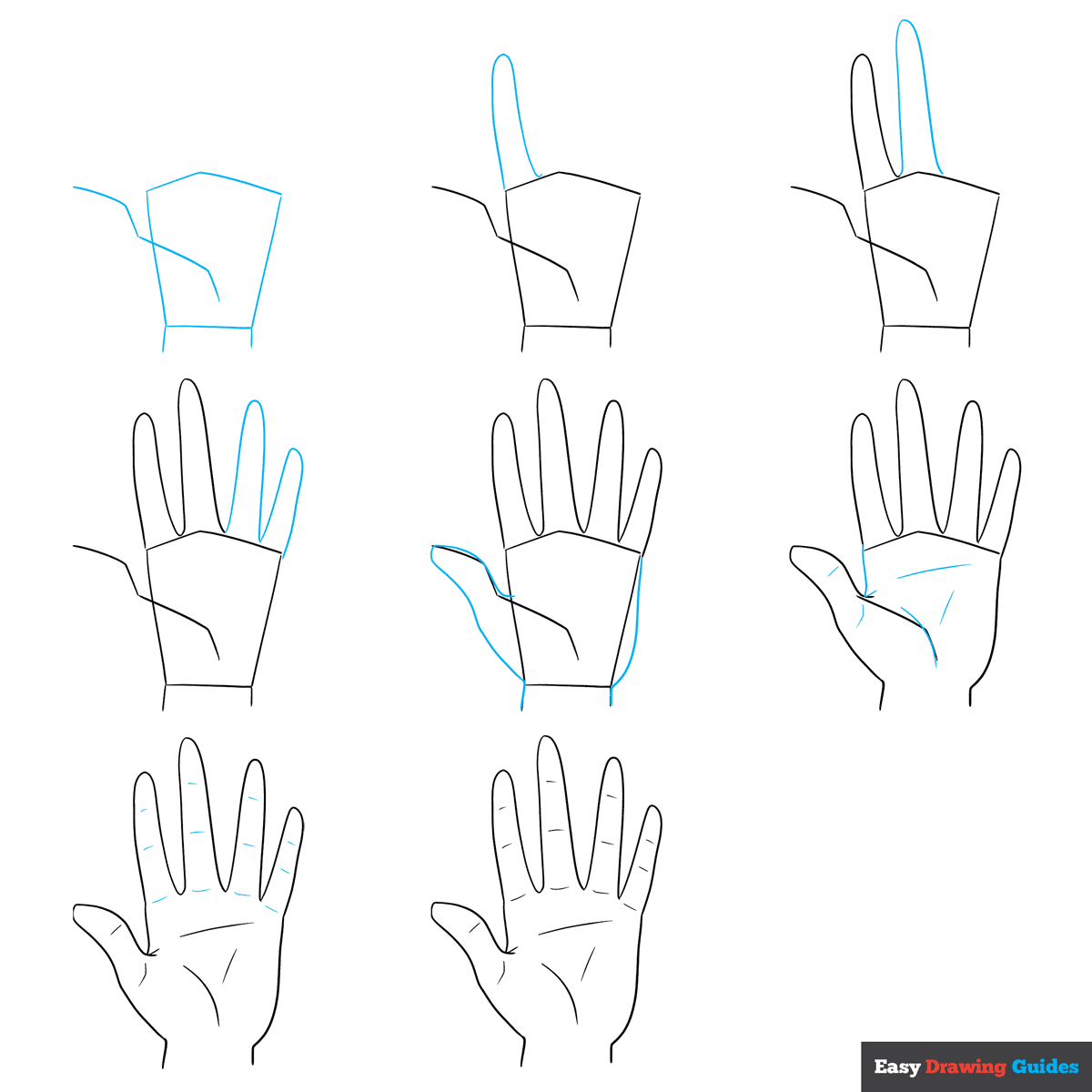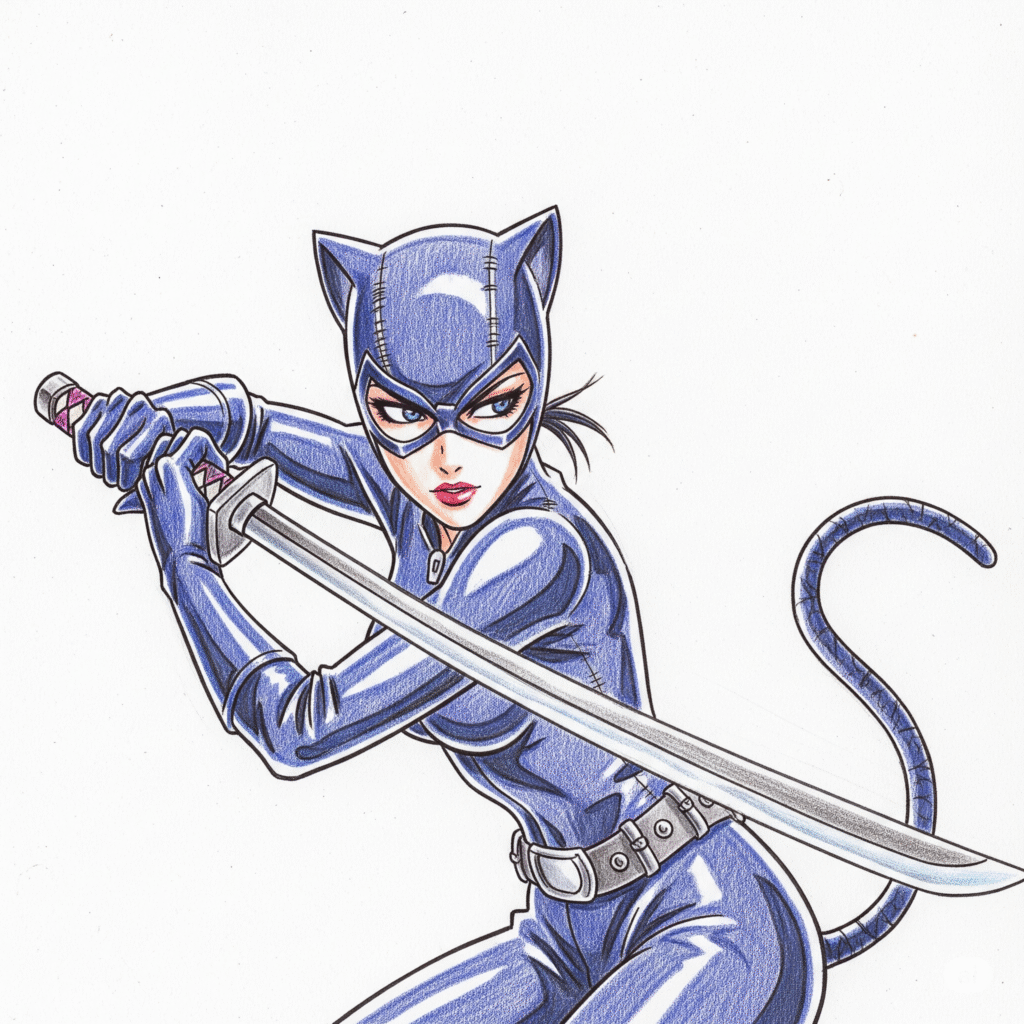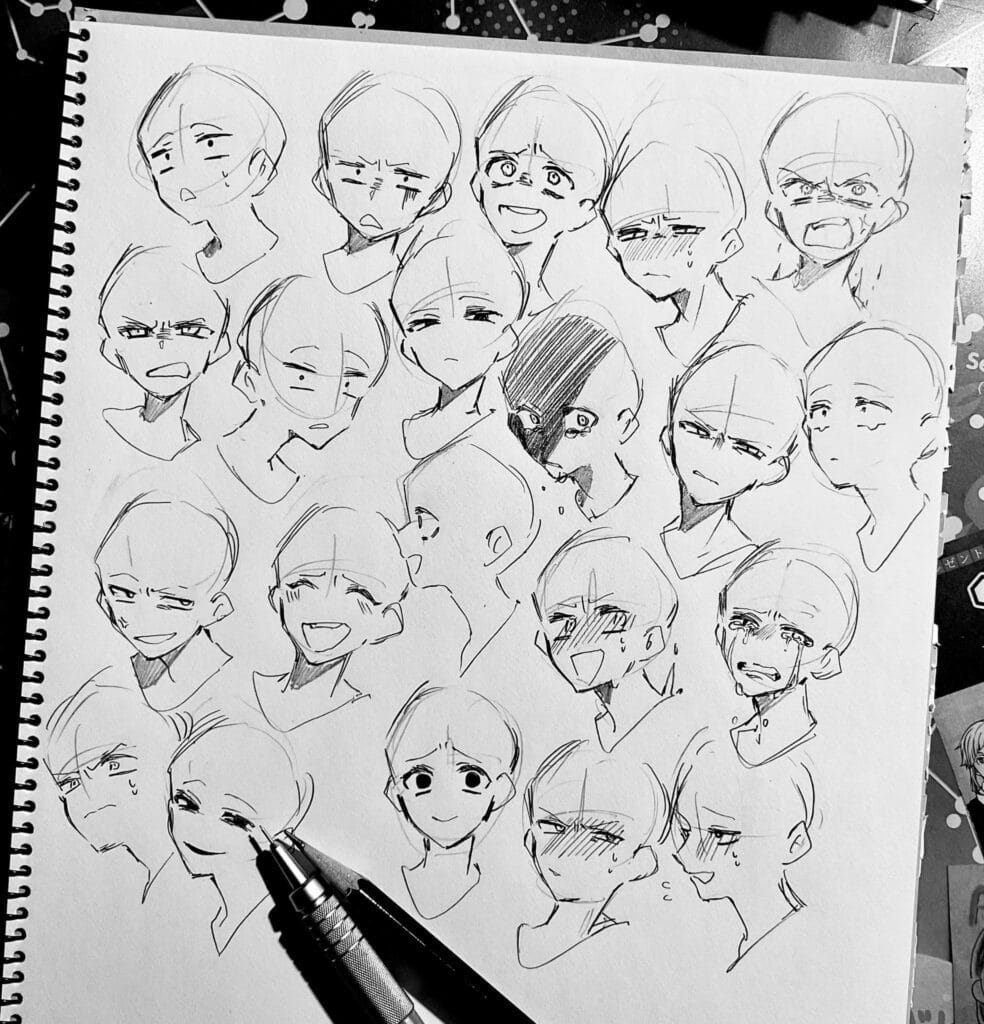
Artist’s hand sketching an anime character with pencil on paper, showing traditional drawing technique
Learning to draw anime characters by hand is more than just putting pencil to paper—it’s about developing a fundamental connection to the art form that will unlock your creative potential and help you design truly original characters. While digital tools offer convenience and efficiency, the traditional approach of hand drawing provides irreplaceable benefits that form the foundation of exceptional anime artistry.
The Foundation: Understanding Basic Shapes and Anatomy
Hand drawing forces you to master the fundamental building blocks of anime art. When creating anime characters, everything begins with basic geometric shapes—circles, squares, and triangles. These simple forms become the foundation for complex character designs:
Circles serve as the base for heads and create soft, friendly appearances that are perfect for kawaii-style characters. Squares and rectangles form the structural elements of bodies and buildings, providing stability and strength to your designs. Triangles create dynamic elements like hair spikes, sharp facial features, and convey energy or aggression.
By practicing these shapes repeatedly with pencil and paper, you develop muscle memory and spatial understanding that becomes second nature. This tactile experience with basic forms is crucial because anime characters, despite their stylized appearance, still follow fundamental anatomical principles.
Developing Your Visual Library Through Traditional Practice
Hand drawing builds what professionals call a “visual library”—a mental collection of forms, proportions, and techniques that you can draw upon when creating original characters. This library develops through:
Life Drawing Practice: Even though anime is stylized, understanding real human anatomy is essential. The biggest recommendation from professional manga artists is life drawing, as it provides the foundation for later stylistic adjustments.
Observational Skills: Drawing by hand trains your eye to see proportions, relationships between forms, and subtle details that might be missed when working digitally. This observational training is what separates amateur work from professional-quality art.youtube
Style Analysis: Hand copying existing anime and manga works teaches you the visual language of the medium. As one professional notes, “The first step is to allow yourself this period of complete lack of originality. Consider yourself like the apprentice learning from a master.”

Step-by-step drawing tutorial showing how to draw an anime-style hand from basic shapes to detailed lines
The Unique Benefits of Traditional Drawing
Muscle Memory and Line Quality
Hand drawing develops superior line control and confidence. Professional manga artists emphasize that clean, confident strokes drawn with the entire arm motion create more dynamic and appealing artwork than hesitant, scratchy lines. This physical skill translates directly into better digital work when you eventually make that transition.youtube
Problem-Solving Skills
Traditional drawing forces you to think through problems rather than relying on “undo” buttons. When you can’t easily erase or transform elements, you learn to plan more carefully and develop stronger compositional skills. This constraint actually enhances creativity by forcing you to work within limitations.youtube
Authentic Expression
Hand-drawn animation maintains what critics call an “honest” quality—a direct connection between the artist’s intent and the final result. Each frame represents someone “breathing life into a character” rather than manipulating digital puppets. This authenticity carries over into character design, where hand-drawn sketches often capture personality more effectively than digital renderings.
Character Creation Through Hand Drawing
The Design Process
Professional character designers follow a specific hand-drawing process that maximizes creativity:
Concept Development: Start with rough thumbnail sketches exploring different personality traits and visual approaches. These quick drawings help you experiment with shape language—using circles for friendly characters, squares for reliable ones, and triangles for dynamic or dangerous personalities.
Refinement Stages: Progress from loose sketches to more detailed drawings, refining proportions and adding characteristic details. Hand drawing allows for easy experimentation with different approaches on the same page.
Expression Studies: Create multiple facial expressions and poses for your character using traditional methods. This helps ensure your design is flexible enough to convey different emotions and situations.
Building Unique Personalities

Hand drawing encourages exploration of character-defining elements :
- Facial features that reflect personality traits
- Hair styles that complement the character’s role and nature
- Body language and proportions that support the character’s story function
- Clothing and accessories that enhance the overall design
The physical act of sketching multiple variations allows for spontaneous discoveries that might not occur in digital workflows.

Hand-drawn anime character head sketches displaying various facial expressions to practice and develop unique anime personalities
Traditional vs. Digital: The Professional Perspective
Many professional anime studios still rely heavily on traditional drawing methods. According to industry reports, the majority of anime post-1990s was still created with pencil and paper, with digital tools primarily used for coloring and effects. Even today, many animators prefer traditional methods for key animation because:
- Speed advantages for experienced artists who can flip through drawings naturally
- Direct tactile feedback that helps with timing and spacing
- Fewer technical barriers that allow focus on pure artistry
- Flexibility in working environments without computer dependencies
Developing Your Personal Style

Hand drawing is essential for developing a unique artistic voice. While digital tools can make artwork look polished, they can also lead to homogenization where many artists’ work appears similar. Traditional practice encourages:
Individual mark-making: Your natural hand movements create distinctive line qualities that become part of your artistic signature.
Personal problem-solving: Working through drawing challenges manually leads to unique solutions and techniques.
Experimentation freedom: The low cost and accessibility of pencil and paper encourage frequent experimentation with different approaches.
Authentic development: Your style emerges naturally through repeated practice rather than being shaped by software limitations.
Building the Foundation for Digital Success
Learning to draw by hand doesn’t mean avoiding digital tools forever. Instead, it provides the foundation that makes digital work more effective. Artists who master traditional techniques first tend to:
- Use digital tools more purposefully rather than relying on filters and effects
- Maintain better drawing fundamentals regardless of medium
- Adapt more easily to new software and technology
- Create more distinctive artwork that stands out in digital portfolios
Professional manga artist Nao Yazawa notes that while digital tools offer efficiency, many artists feel “a computer separating me from my art”. The tactile connection developed through hand drawing provides an essential understanding of the craft that translates into better work in any medium.
Practical Steps to Begin Your Hand Drawing Journey

Start with the fundamentals: Practice basic shapes daily, focusing on circles, squares, and triangles drawn with confident strokes
Study anatomy basics: Even simplified anime anatomy requires understanding of real human proportions.
Copy from masters: Replicate existing anime and manga art to learn visual conventions and techniques.
Develop a routine: Dedicate at least one hour daily to hand drawing practice.
Focus on observation: Draw from life, photos, and references to build your visual library.
Embrace mistakes: Each error in traditional drawing teaches problem-solving skills that digital shortcuts cannot provide.
The Path to Original Character Creation
Through consistent hand drawing practice, you’ll develop the skills necessary to create truly original anime characters that reflect your unique artistic vision. The combination of technical fundamentals, observational skills, and personal expression developed through traditional methods provides the strongest foundation for character design success.
The journey from basic shape drawing to creating compelling original characters requires patience and dedication, but the results—characters that are uniquely yours and crafted with authentic artistic skill—are worth the investment. By mastering the art of hand drawing first, you’ll be equipped with the tools and understanding necessary to bring your anime character visions to life, whether you eventually work traditionally, digitally, or combine both approaches.
Remember, every great anime artist began with simple pencil strokes on paper. Your journey to creating memorable original characters starts with that same fundamental connection between hand, eye, and imagination that has driven artistic expression for centuries.
- https://www.animeoutline.com/how-to-draw-anime-and-manga-hands/
- https://www.skillshare.com/en/blog/how-to-draw-anime-for-beginners-a-step-by-step-guide/
- https://wow-how.com/articles/top-styles-hand-drawn-animation
- https://gvaat.com/blog/how-to-draw-anime-hands-a-step-by-step-tutorial/
- https://www.animeoutline.com/how-to-draw-anime-characters-tutorial/
- https://www.reddit.com/r/anime/comments/kd4kap/are_animations_in_anime_digital_hand_drawn/
- https://www.youtube.com/watch?v=1FDrizAhPa8
- https://www.youtube.com/watch?v=x_v5bHfQgUI
- https://www.youtube.com/watch?v=wRYl1tMUnkE
- https://www.youtube.com/watch?v=xV3PmbBU9c0
- https://www.xp-pen.com/blog/how-to-learn-to-draw-manga.html
- https://www.clipstudio.net/how-to-draw/archives/155309
- https://www.youtube.com/watch?v=MGzoDzWH02c
- https://www.reddit.com/r/ArtistLounge/comments/wrbdnu/in_order_to_learn_to_draw_anime_character/
- https://www.youtube.com/watch?v=Qa3t9hKTda8
- https://www.pinterest.com/epicotaku50/drawing-anime-hands/
- https://www.animeoutline.com
- https://www.voguefashioninstitute.com/the-evolution-of-animation-from-hand-drawn-to-digital/
- https://www.pinterest.com/greywardens/references-of-animemanga-hands/
- https://www.pinterest.com/pin/35-easy-anime-drawing-ideas-how-to-draw-anime–850758185874739934/
- https://www.adobe.com/uk/creativecloud/illustration/discover/how-to-draw-manga.html
- https://www.youtube.com/watch?v=Ou452bGZPQc
- https://stateofgreen.com.au/10-tips-to-boost-your-anime-manga-drawing-skills/
- https://www.reddit.com/r/learnart/comments/2v7m76/your_opinion_on_practicing_drawingstudying/
- https://www.reddit.com/r/Mangamakers/comments/165ocj0/should_i_practice_digitally_or_traditional/
- https://tips.clip-studio.com/zh-cn/articles/3251
- https://www.youtube.com/watch?v=EefqA7epQzk&vl=en
- https://businessofanimation.com/traditional-animator-vs-digital-animator/
- https://www.youtube.com/watch?v=KKFrI8aKrq0
- https://www.youtube.com/watch?v=I06MitK9-Ds
- https://www.animeoutline.com/beginner-guide-to-drawing-anime/
- https://animeartacademy.com
- https://roozrang.com/traditional-vs-digital-animation/
- https://www.youtube.com/watch?v=d2LLrfwHiSc
- https://www.youtube.com/watch?v=bgI8pqezB-c
- https://www.skillshare.com/en/blog/become-a-character-design-anime-artist-a-complete-guide/
- https://www.phot.ai/ai-anime-character-maker
- https://www.youtube.com/watch?v=bUCx3WW8s3g
- https://www.youtube.com/watch?v=-PZ5Yct8eDc
- https://enhancedrawing.com/how-to-get-better-at-drawing-anime/
- https://www.whataportrait.com/blog/character-design-how-to/
- https://www.fotor.com/features/ai-anime-character-creator/
- https://discover.therookies.co/2023/05/05/guide-to-creating-anime-style-characters/
- https://www.youtube.com/watch?v=N2u8DqiPh48
- https://www.youtube.com/watch?v=k43fgw3h53Q
- https://www.reddit.com/r/NovelAi/comments/ya7qgc/tips_for_making_anime_characters_faithful_to_the/
- https://www.youtube.com/watch?v=4MdXcqXg10Y
- https://www.voguefashioninstitute.com/anime-industry-character-design-skill-set-to-become-an-artist/
- https://openart.ai/apps/anime-character
- https://www.faber-castell.in/tutorials/Artists/basic-techniques-anime-movement
- https://www.reddit.com/r/learnart/comments/164h4bb/what_makes_a_good_character_design/
- https://www.youtube.com/watch?v=mEn3CYU7s_A
